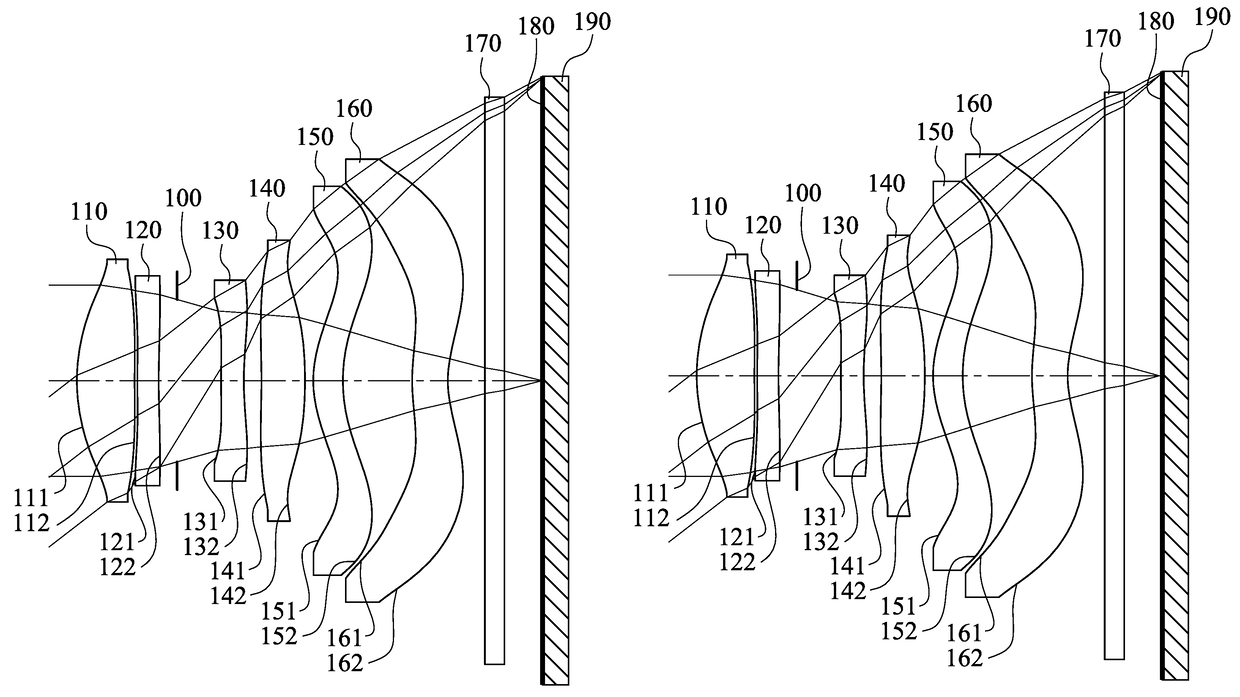Imaging optical lens system, image capturing apparatus and electronic device
an image capturing apparatus and optical lens technology, applied in the field of compact imaging optical lens systems and image capturing apparatuses, can solve the problems of inability to optically adjust the depth of focus, the limitations of imaging optical lens systems and their aperture sizes, and the increased requirements of the photo processing function of these devices by most users
- Summary
- Abstract
- Description
- Claims
- Application Information
AI Technical Summary
Benefits of technology
Problems solved by technology
Method used
Image
Examples
1st embodiment
[0086]FIG. 1A is a schematic view of an image capturing apparatus according to the 1st embodiment of the present disclosure. FIG. 2A shows, in order from left to right, spherical aberration curves, astigmatic field curves and a distortion curve of the image capturing apparatus according to FIG. 1A. In FIG. 1A, the image capturing apparatus includes the imaging optical lens system (its reference numeral is omitted) and an image sensor 190. The imaging optical lens system includes, in order from an object side to an image side, a first lens element 110, a second lens element 120, an aperture stop 100, a third lens element 130, a fourth lens element 140, a fifth lens element 150, a sixth lens element 160, an IR-cut filter 170 and an image surface 180. The image sensor 190 is disposed on the image surface 180 of the imaging optical lens system. There is an air gap and no relative movement between every two of the first lens element 110, the second lens element 120, the third lens elemen...
2nd embodiment
[0120]FIG. 3 is a schematic view of an image capturing apparatus according to the 2nd embodiment of the present disclosure. FIG. 4 shows, in order from left to right, spherical aberration curves, astigmatic field curves and a distortion curve of the image capturing apparatus according to the 2nd embodiment. In FIG. 3, the image capturing apparatus includes the imaging optical lens system (its reference numeral is omitted) and an image sensor 290. The imaging optical lens system includes, in order from an object side to an image side, a first lens element 210, a second lens element 220, an aperture stop 200, a third lens element 230, a fourth lens element 240, a fifth lens element 250, a sixth lens element 260, an IR-cut filter 270 and an image surface 280. The image sensor 290 is disposed on the image surface 280 of the imaging optical lens system. There is an air gap and no relative movement between every two of the first lens element 210, the second lens element 220, the third len...
3rd embodiment
[0135]FIG. 5A is a schematic view of an image capturing apparatus according to the 3rd embodiment of the present disclosure. FIG. 6A shows, in order from left to right, spherical aberration curves, astigmatic field curves and a distortion curve of the image capturing apparatus according to FIG. 5A. In FIG. 5A, the image capturing apparatus includes the imaging optical lens system (its reference numeral is omitted) and an image sensor 390. The imaging optical lens system includes, in order from an object side to an image side, a first lens element 310, a second lens element 320, an aperture stop 300, a third lens element 330, a fourth lens element 340, a fifth lens element 350, a sixth lens element 360, an IR-cut filter 370 and an image surface 380. The image sensor 390 is disposed on the image surface 380 of the imaging optical lens system. There is an air gap and no relative movement between every two of the first lens element 310, the second lens element 320, the third lens elemen...
PUM
 Login to View More
Login to View More Abstract
Description
Claims
Application Information
 Login to View More
Login to View More - R&D
- Intellectual Property
- Life Sciences
- Materials
- Tech Scout
- Unparalleled Data Quality
- Higher Quality Content
- 60% Fewer Hallucinations
Browse by: Latest US Patents, China's latest patents, Technical Efficacy Thesaurus, Application Domain, Technology Topic, Popular Technical Reports.
© 2025 PatSnap. All rights reserved.Legal|Privacy policy|Modern Slavery Act Transparency Statement|Sitemap|About US| Contact US: help@patsnap.com



